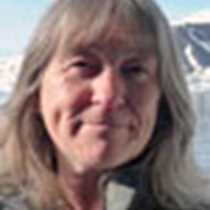Storøya, Nordaustlandet, Northeast Svalbard
It was early in the morning, and it was a fine thing to be up and on the bridge when the National Geographic Explorer reached her furthest north point of the voyage, at 80º 54’ north just before 6am. We were far out to the northeast of Northaustlandet, and had spent an unearthly night gently wrapped in fog among the sea ice. This is a common phenomenon in calm weather in the Arctic where cold air from the sea ice meets damp air above. With the air temperature now at 0º C, ice was starting to form on the handrails on the ship and, between the ice floes, the open water was covered in a thin film of ‘grease’ ice which had formed overnight.
Turning now to the southwards, we headed back towards the island of Storøya, feeling a gentle swell as we left the pack ice behind, accompanied now and then by a cluster of little awks or dovekies.
Miraculously, at Storøya the fog cleared sufficiently to see this extraordinary, rarely-visited island and its extraordinary inhabitants. Its 33 square kilometres lie mostly under an ice cap 250m thick. Only the northern part is ice-free, a low-lying slope of gravel and pebbles with many small lakes. No-one, however, anticipated the wonderful experience that awaited us there. What at first glance appeared to be rounded rocks just offshore transpired to be heaps of walruses, as well as a very large group lying together on the beach. Most of the walruses seen in Svalbard in the summer months are male, as the females give birth and nurse their young further to the east. Here, however, in this remote and usually quite inaccessible place, were groups of females with calves of all ages. In the water were countless more animals, swimming about in tight formations. One young calf decided to haul out on the rocks with a group of adults, who gently rolled aside to make room for the new arrival. Arctic terns swooped over the bay, feeding amongst the swimming walruses. It was impossible to estimate the numbers of walrus, but it must have exceeded 300 individuals, the biggest gathering most of us have ever seen.
But most compelling of all was the sight of polar bears pacing about on the fringes of the haul-outs. Around seven of these predators could be seen, watching and waiting for an unguarded youngster or a vulnerable adult. The walruses on the shore remained vigilant, tusks ready, and kept up a loud steady noise, quite different from the occasional contented grunt usually heard. During the time we watched from Zodiacs, the walrus guard was maintained, and no bear got any dinner. But now that the sea ice is so far diminished, the bears will remain on Storøya until the ice returns in the autumn, ever watchful, growing hungrier and more determined with every day. What is there to compare with the drama of nature witnessed firsthand.




